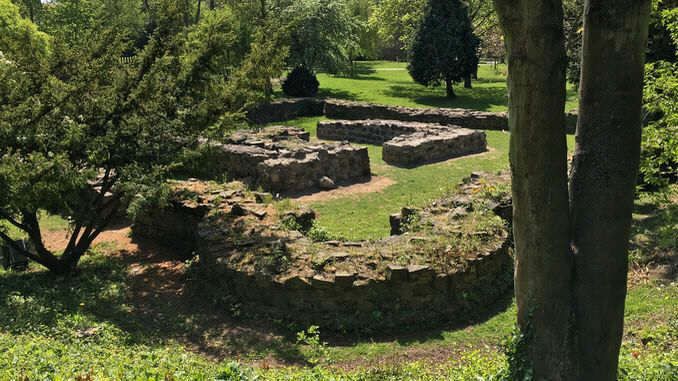
Let us go down from the Siebengebirge to the bank of the Rhine. Here, in Bad Honnef-Rhöndorf, we find the ruins of the small medieval Reitersdorf Castle. Today, the castle is in the middle of the beautiful park Reitersdorf.
Count Johann I.
Reitersdorf Castle was built around 1270 by count Johann I. von Heinsberg, lord of the Löwenburg. He had just inherited the Mount Löwenburg and the Castle on top and set out to live there. However, the Count of Wolkenburg, the Knights of the Teutonic Order in the nearby village Ramersdorf and an officer of the archbishopric of Cologne disputed his rights. They even chased him out of his Löwenburg Castle and his territories.
Back then, Johann I. started building the small castle down by the Rhine in Reitersdorf, in medieval spelling Reyterstorp. In the beginning, it was only a simple tower house. We know little about these years of turmoil and armed conflicts, and the fragments do not give a true picture. Perhaps Johann I had Reitersdorf Castle built as substitute for Löwenburg. Eventually, the archbishop of Cologne, Engelbert von Falkenburg, managed to settle the dispute. Now Johann I could move into Löwenburg Castle and rightfully call himself “Lord of Löwenberg”.
A fortified little castle
Years later, Johann I fought on the archbishop’s side in the disastrous battle of Worringen in 1288. They were defeated and taken prisoner. Johann I became an involuntary liegeman of the Count of Jülich and had to transfer Reitersdorf Castle to him. The Count of Jülich had the small tower house converted into a moated castle with strong walls, corner towers and an outer castle. This little enemy fortress within his territory must have been a thorn in the side of the archbishop of Cologne.
Johann I married twice, and he had sons from both marriages. When he died in 1306, his son Heinrich I. became Lord of the Löwenburg (1306-1343).
After the sudden death of Holy Roman Emperor Henry VII in Italy in 1313, there was a double election. The majority of the prince-electors voted for Louis IV of the House of Wittelsbach, acting Count Palatine. We also refer to him as “Louis the Bavarian”. The minority, however, voted for the Frederick “the Fair” of the House of Habsburg. Among them was the archbishop of Cologne, Heinrich II of Virneburg. Again a double election led to civil war.
War for the throne and destruction
This war also divided the family on Löwenburg Castle. Heinrich I was on the archbishop’s side, so he supported Friedrich of Habsburg. His stepbrother Johann II from his father’s second marriage, however, was on the Count of Jülich’s side. They supported Louis. Reitersdorf Castle belonged to Johann II. Again our region was devastated by a war. That is to say, the opponents destroyed their enemies’ farms and houses, depriving people of their livelihood. Thinking of all the suffering affects us still today. The archbishop’s troops destroyed Reitersdorf castle.
Read more (German)
Park Reitersdorf, Historie

Be the first to comment